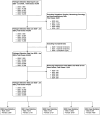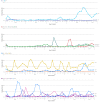Impact of COVID-19 pandemic measures on hospitalizations and epidemiological patterns of twelve respiratory pathogens in children with acute respiratory infections in southern China
- PMID: 39844061
- PMCID: PMC11756097
- DOI: 10.1186/s12879-025-10463-y
Impact of COVID-19 pandemic measures on hospitalizations and epidemiological patterns of twelve respiratory pathogens in children with acute respiratory infections in southern China
Abstract
Objectives: To investigate the impact of COVID-19 pandemic measures on hospitalizations and the alterations and persistence of the epidemiological patterns of 12 common respiratory pathogens in children during the COVID-19 pandemic and after the cessation of the "zero-COVID-19" policy in southern China.
Methods: Respiratory specimens were collected from hospitalized children with acute respiratory infections at Shenzhen Children's Hospital from January 2020 to June 2024. Twelve common respiratory pathogens were detected using multiplex PCR. Data on demographic characteristics, pathogen detection rates, epidemiological patterns, co-infections, and ICU admission rates were compared between the 'during COVID-19' period (Phase 1: January 2020 to December 2022) and the 'post COVID-19' period (Phase 2: January 2023 to June 2024).
Results: In Phase 2, there was a significant increase in average annual cases, with a higher median age of affected children, higher pathogen detection rates, and increased co-infection rates compared to Phase 1. The epidemiological patterns of most pathogens were altered by the COVID-19 pandemic. Human Parainfluenza Virus, Human Metapneumovirus, Human Bocavirus (HBOV), and Human Coronavirus remained active during Phase 1, while Mycoplasma pneumoniae (Mp) and Adenovirus (ADV) were low, and Respiratory Syncytial Virus (RSV) lacked a seasonal peak in 2022. In Phase 2, Mp, ADV, and RSV experienced outbreaks, with Mp's high prevalence continuing into 2024. RSV showed out-of-season epidemics for two consecutive years. Influenza A (H1N1), Influenza A (H3N2), and InfB lost their seasonal patterns during Phase 1 but reemerged and regained their seasonal characteristics in 2023-2024. ICU admission rates did not significantly differ between the two phases, except for HBOV, which had higher rates in Phase 2.
Conclusion: The epidemiological patterns of various respiratory pathogens were affected by the COVID-19 pandemic to varying degrees. Pathogens suppressed during the pandemic experienced outbreaks or out-of-season epidemics after the lifting of non-pharmaceutical interventions, with Mp and RSV continuing into the second year and HBOV associated ICU admission rates increasing in the post-pandemic era. Continuous monitoring of these patterns is essential to understand the duration of these effects and to inform effective response strategies.
Keywords: Acute respiratory infection; COVID-19; Children; Epidemiology; Non-pharmaceutical interventions; Pathogens.
© 2025. The Author(s).
Conflict of interest statement
Declarations. Ethics approval and consent to participate: The need for informed consent was waived by the Ethics Committee of the Shenzhen Children’s Hospital because of the retrospective nature of the study. Consent for publication: Not applicable. Clinical trial number: Not applicable. Competing interests: The authors declare no competing interests.
Figures





Similar articles
-
Epidemiology of respiratory pathogens in patients with acute respiratory infections during the COVID-19 pandemic and after easing of COVID-19 restrictions.Microbiol Spectr. 2024 Nov 5;12(11):e0116124. doi: 10.1128/spectrum.01161-24. Epub 2024 Sep 25. Microbiol Spectr. 2024. PMID: 39320069 Free PMC article.
-
Changes in the epidemic patterns of respiratory pathogens of children in guangzhou, China during the COVID-19 pandemic.BMC Infect Dis. 2025 Jul 1;25(1):833. doi: 10.1186/s12879-025-11215-8. BMC Infect Dis. 2025. PMID: 40597730 Free PMC article.
-
Analysis of respiratory pathogen detection in hospitalized children with acute respiratory tract infections after ending the zero COVID policy.Sci Rep. 2024 Dec 30;14(1):31784. doi: 10.1038/s41598-024-82660-9. Sci Rep. 2024. PMID: 39738485 Free PMC article.
-
Epidemiology, Clinical Significance, and Diagnosis of Respiratory Viruses and Their Co-Infections in the Post-COVID Era.Pathogens. 2025 Mar 7;14(3):262. doi: 10.3390/pathogens14030262. Pathogens. 2025. PMID: 40137747 Free PMC article. Review.
-
Characterising the asynchronous resurgence of common respiratory viruses following the COVID-19 pandemic.Nat Commun. 2025 Feb 13;16(1):1610. doi: 10.1038/s41467-025-56776-z. Nat Commun. 2025. PMID: 39948338 Free PMC article.
Cited by
-
Evaluation of common respiratory viruses other than SARS-CoV-2 in hospitalized children during the COVID-19 pandemic.BMC Infect Dis. 2025 Jul 11;25(1):910. doi: 10.1186/s12879-025-11293-8. BMC Infect Dis. 2025. PMID: 40646473 Free PMC article.
-
Re-emergence of Mycoplasma pneumoniae before and after COVID-19 pandemic in Germany.BMC Infect Dis. 2025 Mar 6;25(1):318. doi: 10.1186/s12879-025-10657-4. BMC Infect Dis. 2025. PMID: 40050786 Free PMC article.
-
Epidemiology and clinical characteristics of human rhinovirus in hospitalized children and adolescents with acute respiratory infections: a longitudinal study in Shenzhen, China (2019-2024).Virol J. 2025 Aug 14;22(1):280. doi: 10.1186/s12985-025-02901-9. Virol J. 2025. PMID: 40814124 Free PMC article.
-
Dynamics of Absences Due to Respiratory Infections, Including COVID-19, Among Medical Staff in a Regional Pediatric Hospital.Healthcare (Basel). 2025 Mar 5;13(5):563. doi: 10.3390/healthcare13050563. Healthcare (Basel). 2025. PMID: 40077125 Free PMC article.
References
-
- The Lancet Respiratory M. Patterns of respiratory infections after COVID-19. Lancet Respir Med. 2024;12(1):1. 10.1016/s2213-2600(23)00472-1. - PubMed
MeSH terms
Grants and funding
LinkOut - more resources
Full Text Sources
Medical

